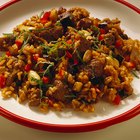
Eising/Digital Vision/Getty Images
Blanching refers to boiling food for a short period of time, then halting the cooking process quickly. When a recipe calls for blanching rice, it simply means to boil the rice briefly, then drain it before proceeding with the recipe. Blanching removes some of the starch from the rice, making it suitable for dishes in which a creamy grain is the key. These days, you're most likely to see the term either in period cookbooks or as the first stage of dessert or risotto recipes.
Method
When a recipe calls for blanching, start by putting the specified amount of uncooked rice in a pot with about four times the volume of water as rice, unless the recipe specifies liquids or amounts. Turn the burner to high and boil the rice for the amount of time specified in the recipe -- usually no more than seven or eight minutes. Stir the rice frequently during the boiling stage. After boiling the rice, drain it in a colander and rinse it if the recipe calls for it.
Rice Pudding
Blanching rice for baked desserts like rice puddings removes the starch from rice while partially cooking the grains. The bulk of the cooking process for desserts such as pudding occurs slowly, in a custard base. Blanching the rice first ensures that the kernels gelantinize, or swell to their proper size, by the time the pudding itself has set. Rice pudding recipes generally call for you to blanch rice by boiling it with sugar for about five minutes before draining, rinsing and adding it to the other ingredients.
Risotto
Risotto is prized for its creamy quality, which results from the cooking technique and the the grain used: arborio rice. To remove some of the starch from the rice beforehand, both rinse and blanch the rice. After rinsing it in a fine-mesh colander, add rice to chicken stock and boil for seven minutes before draining. This step not only removes starch, but infuses the grains with the flavor of the stock. Don't rinse after draining, but set the rice on an oiled platter to finish drying.
When to Skip it
Modern cleaning and processing techniques mean that you rarely have to blanch rice to ensure cleanliness and proper texture. Unless a recipe says otherwise, forgo the blanching stage before boiling, simmering or steaming the rice. If a recipe or rice packaging specifies additional stages before cooking, such as soaking, rinsing or sauteing the rice, follow the steps on the package or recipe exactly without adding the blanching step unless blanching is specifically advised.
Related Articles

How to Cook Long Grain Rice

Differences Between Steamed & Boiled ...

What Is a Semibrown Rice Zojirushi?

How to Cook Rice Flakes

How to Cook Rice in a Steamer

How to Boil Rice

Does Rice Taste Different Depending on ...
Quick and Easy Spanish Rice Recipe

How to Replace Wheat

How to Cook Red Camargue Rice
How to Cook Volcano Rice

How to Dry Out Sticky Rice

How to Make Rice With a Bamboo Steamer

What Rice Takes the Longest Time to ...

How to Extract Starch From Rice Bran

How Long After a Sell-By Date Can You ...

How to Cook Japanese Rice

The History of Risotto

How to Cook Rice Without a Rice Cooker

Brown Basmati Rice Cooking Directions
References
Writer Bio
Ellen Douglas has written on food, gardening, education and the arts since 1992. Douglas has worked as a staff reporter for the Lakeville Journal newspaper group. Previously, she served as a communication specialist in the nonprofit field. She received her Bachelor of Arts from the University of Connecticut.
Photo Credits
Eising/Digital Vision/Getty Images